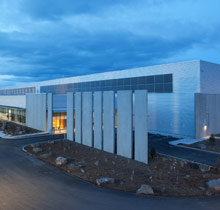The social network breaks an unwritten rule by giving away plans to its new data center—an action it hopes will make the Web more efficient.
Just weeks before switching on a massive, super-efficient data center in rural Oregon, Facebook is giving away the designs and specifications to the whole thing online. In doing so, the company is breaking a long-established unwritten rule for Web companies: don't share the secrets of your server-stuffed data warehouses.
Ironically, most of those secret servers rely heavily on open source or free software, for example the Linux operating system and the Apache webserver. Facebook's move—dubbed the Open Compute Project—aims to kick-start a similar trend with hardware.
"Mark [Zuckerberg] was able to start Facebook in his dorm room because PHP and Apache and other free and open-source software existed," says David Recordon, who helps coordinate Facebook's use of, and contribution to, open-source software. "We wanted to encourage that for hardware, and release enough information about our data center and servers that someone else could go and actually build them."
The attitude of other large technology firms couldn't be more different, says Ricardo Bianchini, who researches energy-efficient computing infrastructure at Rutgers University. "Typically, companies like Google or Microsoft won't tell you anything about their designs," he says. A more open approach could help the Web as a whole become more efficient, he says. "Opening up the building like this will help researchers a lot, and also other industry players," he says. "It's opening up new opportunities to share and collaborate."
The open hardware designs are for a new data center in Prineville, Oregon, that will be switched on later this month. The 147,000-square-foot building will increase Facebook's overall computing capacity by around half; the social network already processes some 100 million new photos every day, and its user base of over 500 million is growing fast.
The material being made available—on a new website—includes detailed specifications of the building's electrical and cooling systems, as well as the custom designs of the servers inside. Facebook is dubbing the approach "open" rather than open-source because its designs won't be subject to a true open-source legal license, which requires anyone modifying them to share any changes they make.
The plans reveal the fruits of Facebook's efforts to create one of the most energy-efficient data centers ever built. Unlike almost every other data center, Facebook's new building doesn't use chillers to cool the air flowing past the servers. Instead, air from the outside flows over foam pads moistened by water sprays to cool by evaporation. The building is carefully oriented so that prevailing winds direct outside air into the building in both winter and summer.
